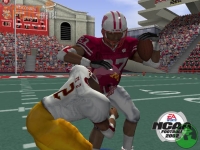So it's with that in mind that we take a look at NCAA Football 2002 today. Unlike last year, NCAA 2002 actually has the jump on the competition from 989 Sports, giving Sony's sports division a tough act to live up to. And we do mean tough; NCAA 2002 is far from perfect (we'll get into that shortly), but it is the best console college football game on the market; some would say the best football game, period...until Madden 2002 and NFL2k2 come out, at least.
See, the reason for that qualification is simple -- NCAA 2002 is based on the admittedly flawed Madden 2001 engine. Don't get me wrong -- it's still solid in its own right, but it suffers from some flaws that plagued Madden 2001. There have been some improvements, but I'm inclined to believe that those improvements are related more to the vast differences between the top-tier and bottom-tier teams in the NCAA than any real AI improvements.
Perhaps I ought to explain. Anybody familiar with Madden 2001 is undoubtedly familiar with the vagaries of its gameplay -- particularly the passing and running games. You see, the two more or less go hand-in-hand. Like Madden, the computer still seems to have the Midas touch where the aerial attack is concerned. It's not at all unusual to see the computer complete a dozen consecutive passes. Of course, the fact that the computer consistently abandons the running game extremely early may go a long way towards explaining that. If you're not running the ball, you gotta pass it. If you can't pass it effectively, you're not going to challenge the gamer. Ergo, wide receivers become Superman incarnate, and the secondary for human-controlled teams lose a coupla dozen IQ points. However, there are some improvements in the secondary. In Madden, it wasn't at all unusual to see the computer come up with convenient 80 yard TD passes with the game on the line. This still happens occasionally in NCAA 2002, but it's much, much less frequent, lending it more of an air of authenticity and less of an "Oh, like I didn't expect THAT to happen" feel. This is in large part due to the fact that, while the secondary is still less aggressive than I'd like, they now have the foresight to keep the wideouts in FRONT of them, as opposed to behind them. Unfortunately, the defense still has a devil of a time picking up the patterns from the tight end, which tends to result in an automatic first down about 95% of the time (and 1,000 yard receiving seasons from said TE). This was also a problem in Madden 2001, and something that's supposedly been tweaked for Madden 2002.




 Outstanding!
Outstanding!





